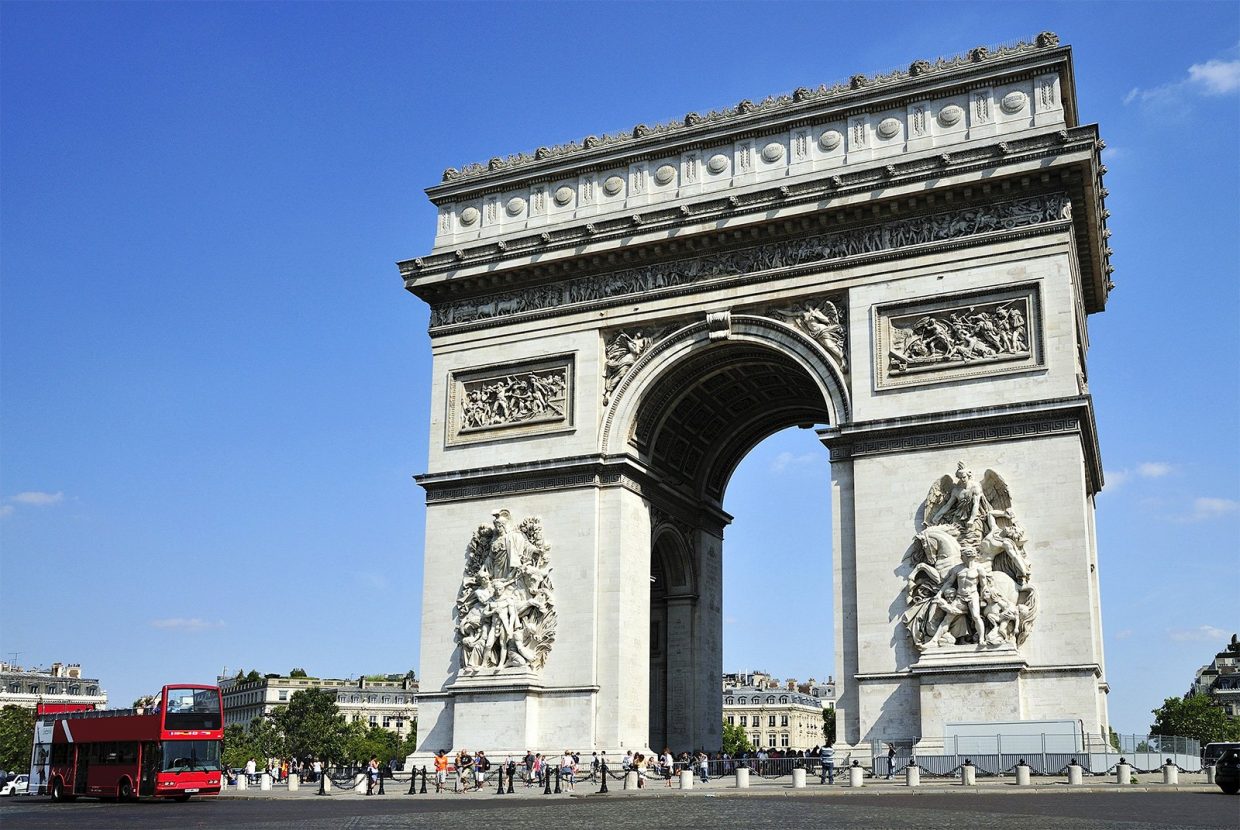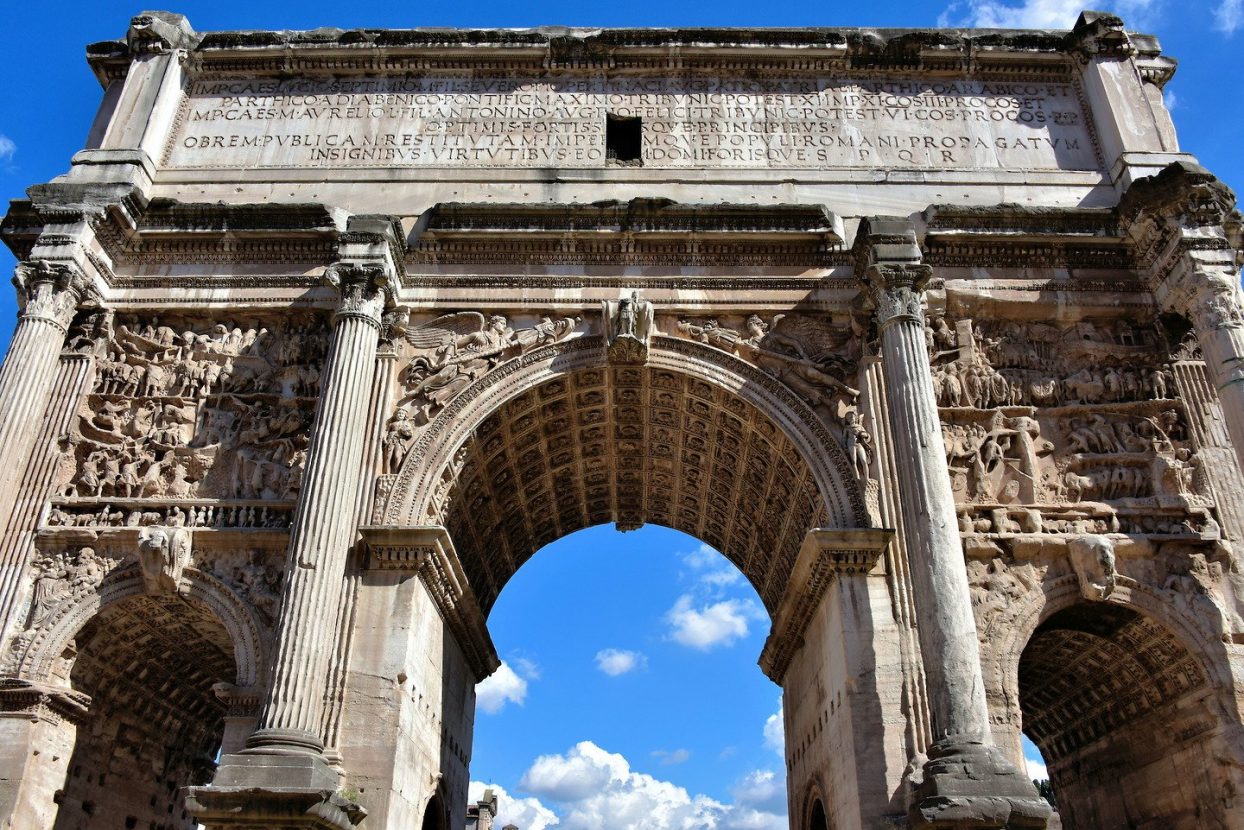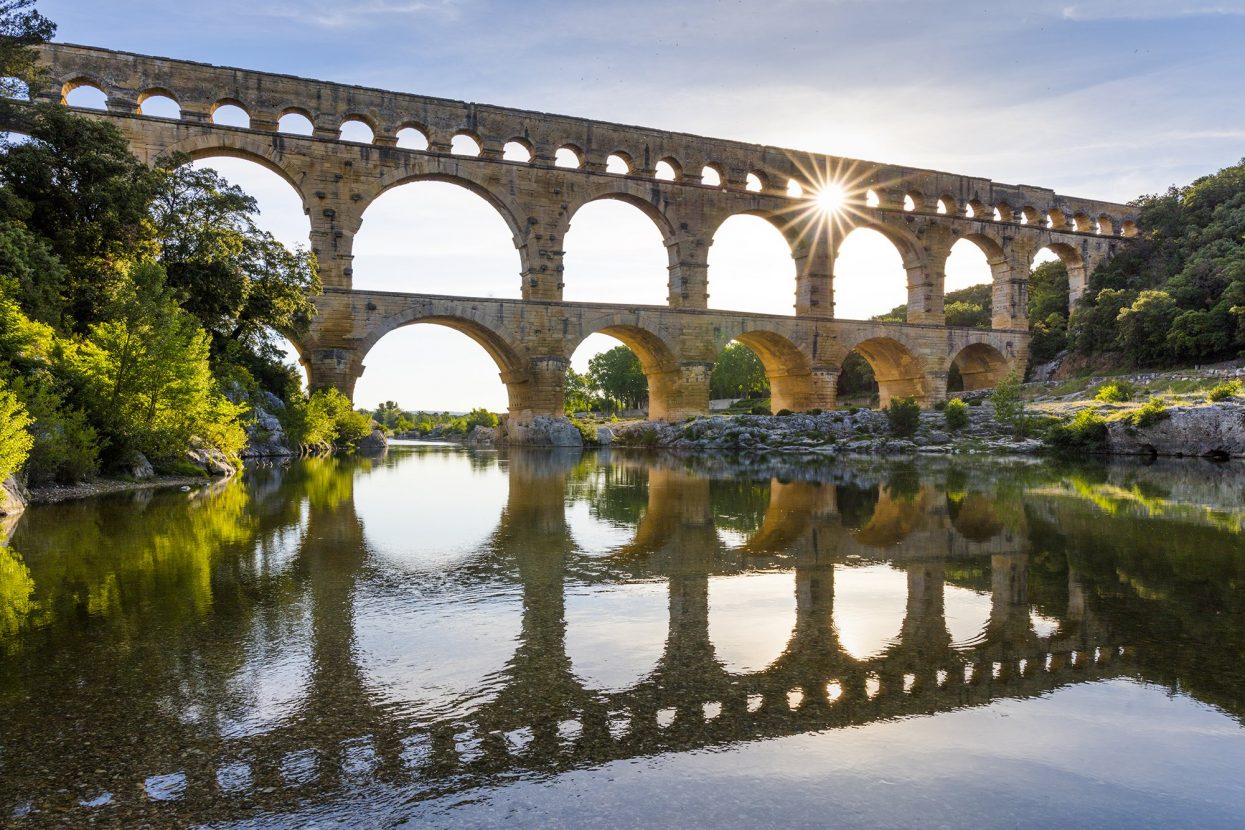Surviving Ancient Roman Architecture: How?
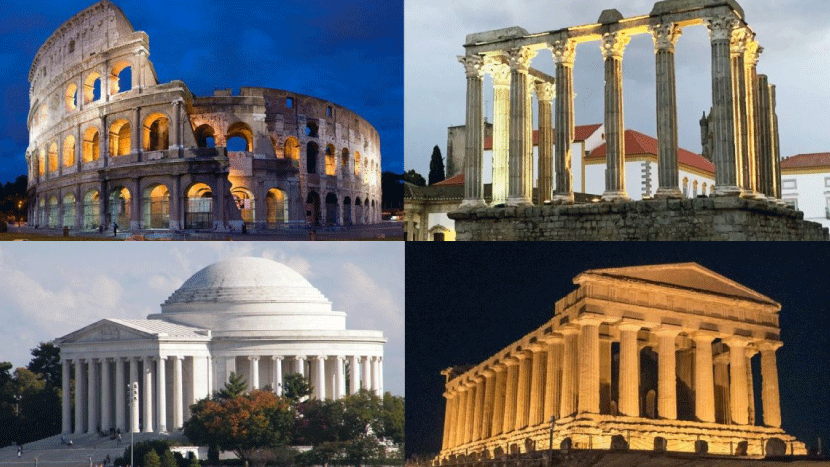 Image Credits: Wikimedia Commons
Image Credits: Wikimedia Commons
A French phrase from 1190 AD goes “Rome ne fu[t] pas faite toute en un jour”. In English, we know this as “Rome wasn’t built in a day”. Indeed, ancient Roman architecture is a wonder which never ceases to amaze, regardless of numerous architectural progressions over the years. For the Romans, their architectural feats held the power and promise for being the world’s most advanced civilization in the era of their establishment.
Contents
Ancient Roman Architecture at a Glimpse
Evidently enough, modern architecture has the provenance and heritage of Rome. The influence it had on the nations left them in an everlasting challenge to live up to Romans’ excellent structures. Today, we can witness hints of ancient roman architecture buildings meticulously expressed in important places of interest. Signature Roman structures such as columns, domes and arches found their way into many modern buildings.
French architects were especially inspired and it resulted in most of Paris following the footsteps of Romans. The most famous notable structures are of course the Place Vendôme and Arc de Triomphe.
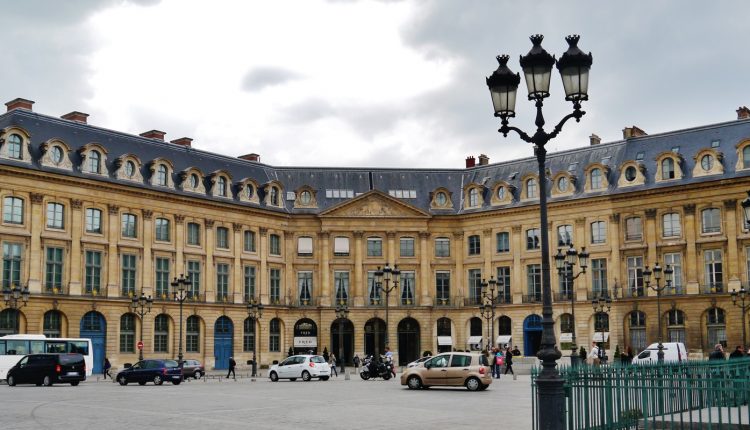
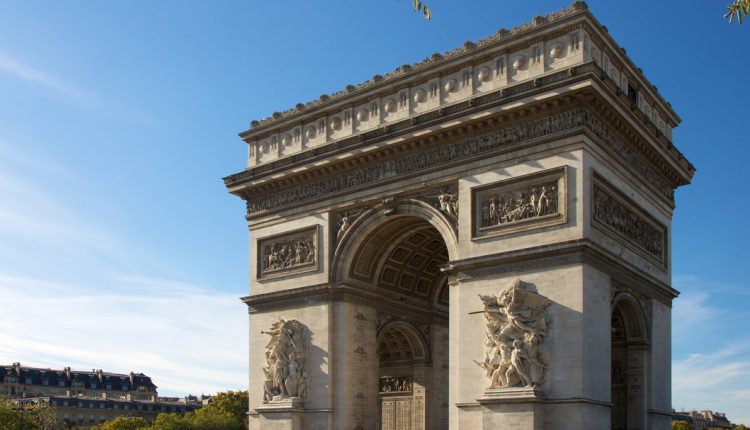
The White House, Washington DC, can also be observed to have been built upon similar attributes of ancient Roman architecture featuring columns and arches through and through.
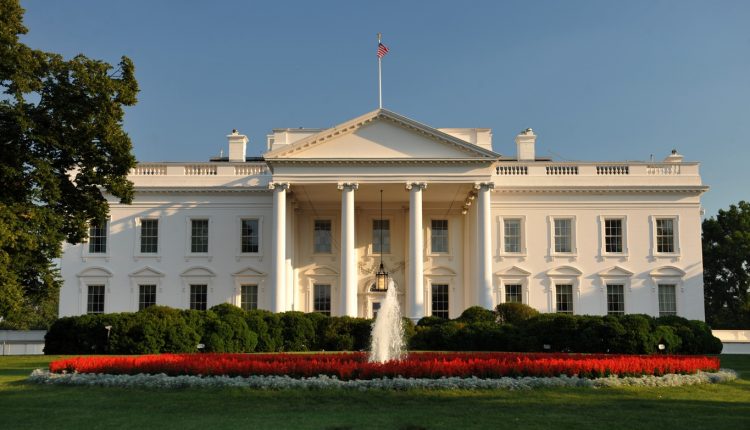
The interior of Union Station in Washington D.C. and the Jefferson Memorial also flaunt the architectural grandeur that is rooted in Roman origin.
This boils down to a handful of questions: Why has ancient Roman architecture seen so much success? How is it still a blueprint for modern structures? And perhaps most importantly, how was it conceived and implemented, at all, in the first place?
This article will not only answer these questions, but also serve as a guide to the thorough background, progress and influence of ancient Roman architecture.
The Birth of Ancient Roman Architecture
The Romans adored the beauty of Greek architecture, just as much as they admired the Greek culture itself. Not only was almost every Roman citizen familiar with Greek ideologies, but they even spoke Greek along with native Latin.
This influence seeped into ancient Roman architecture, and thus they adopted the Greek style of post-and-lintel. This comprised of massive upright posts that had horizontal blocks (i.e lintel) laid flat on top. This style, however, mostly served to be visually pleasing because owing to the weight of the lintel, it was only used in small buildings and allowed for very less internal space. This served the Greeks well because they used these buildings to house their “Gods” and store valuables. Whereas, the outsides were the altars which were accessible to worshippers.
However, the Romans were rather practical than idealists. They needed inside space, since the worshippers had to seek shelter from the rainy region of Rome while they worshipped. This drove the Romans to explore more possibilities, enabling them to gradually discover tricks, like the Columns and Arches, that would lead to monuments of unprecedented size, grandeur and practicality.
The Classical Architecture Orders
The Greeks always used three distinct styles of column tops, “capitals”, namely Doric, Ionic and Corinthian styles.
The Doric style
The Doric style was the simplest and most basic type of capital, neither profusely beautified nor used in important buildings. Its sole purpose was to hold up heavy tops.
The Ionic style
The Ionic style had a more decorated base and top and served just like a Doric style capital would. The Corinthian was the king of all capitals; with its splendid details, it was favored in many important buildings.
The Corinthian style
The Romans, however, incorporated their own creativity thus their version of the Corinthian capital became much more decorative. The Tuscan Capital was another adaptation of the traditional Doric column but modified with a smaller capital, slenderer shaft without flutes, and a moulded base. The Composite Capital was a hybrid which mixed the volute of the Ionic order with the acanthus leaves of the Corinthian.
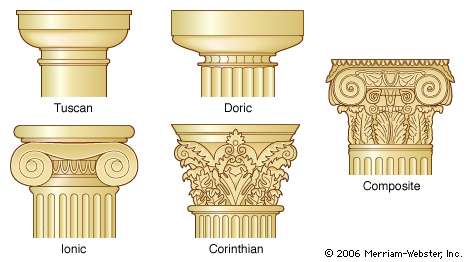
Materials and Techniques used in Ancient Roman Architecture
Initially, Romans made use of a volcanic stone native to Italy called “tufa” in the construction of their buildings. Slowly, travertine began to catch on along with tufa in the late 2nd century B.C.E. Not only was travertine more durable, but its off-white colour made it an acceptable substitute for marble. Marble, even though seen as too extravagant, did however, make its place as an integral Roman building feature. There was a surge in building activity, innovation in design, and extravagant use of marble during the Augustan Period. As he famously claimed in his funerary inscription, the Res Gestae, that he “found Rome a city of brick and left it a city of marble”, which is true.
By early 2nd century BCE, Roman concrete (opus caementicium) was developed, which was a game-changer. Even though mortar (a combination of sand, lime and water in proper proportions) was a familiar bonding agent in the ancient world, the Romans added a magic ingredient which was strong, durable and had the ability to set underwater. This was volcanic Italian sand also known as “pozzolana”. This method of using concrete was not actually attractive visually, but it permitted the architects the freedom to design buildings with more flexibility.
Eventually, marble veneers entered the construction picture. This meant that the entire structures would be made out of concrete, but eventually tiled with marble such as to create the illusion of the entire building being built out of marble. Since concrete was significantly cheaper than marble or any other traditionally used stone, these alternatives not only provided more structural opportunities but were also more economical.
Arches were also featured in buildings across the ancient world. It was not until the Romans developed the True Arch that this shape would become a widespread sight. Traditionally, only the corbeled arches were constructed, where stones are laid so that they move slightly in toward the centre as they move higher. The innovation here is that, instead, the arch is composed of wedge-shaped blocks of voussoirs, which is a durable stone, with a keystone in the centre holding them into place.
This way, the weight is transferred from one voussoir down to the next, from the top of the arch to ground level, creating a sturdy building structure. Because concrete is much lighter, and true arches can span much wider and farther with stability, this combination allowed the interiors of Roman structures to now be fully expansive to suit their needs.
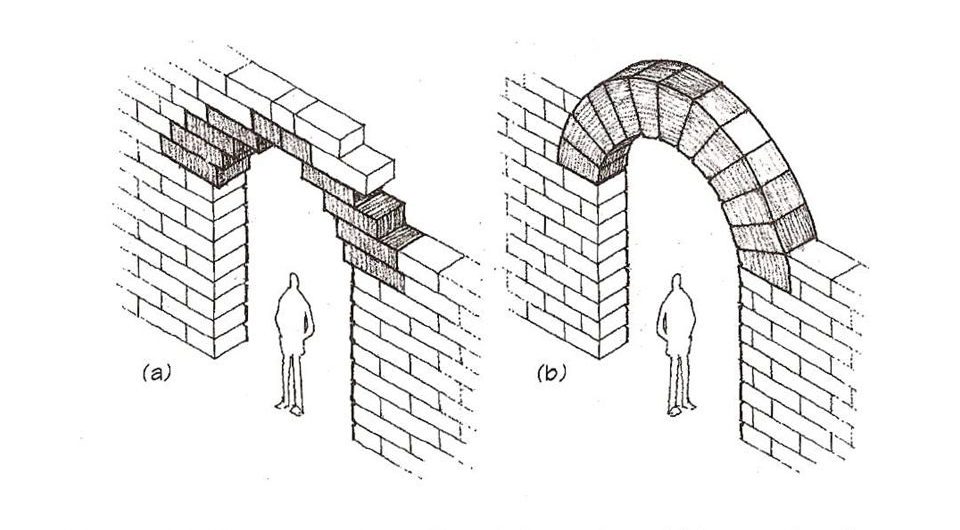
Vault, in architecture, is a self-supporting arched form serving to cover a space with a ceiling or roof. The barrel vault, (also known as wagon and tunnel vault) is a continuous arch, the length being greater than its diameter. Since the height of a barrel vault must always increase with increasing width, this put a practical limit on its size. Once again, in this aspect, Roman architects came up with two innovative solutions; The dome, which can cover a large circular area, and secondly, the groin vault, which is the intersection when two semicircular barrel vaults of the same diameter cross one another (a true ellipse). This concentrates the entire weight of the roof at four points and allows the required supportive walls to be reduced to four posts.
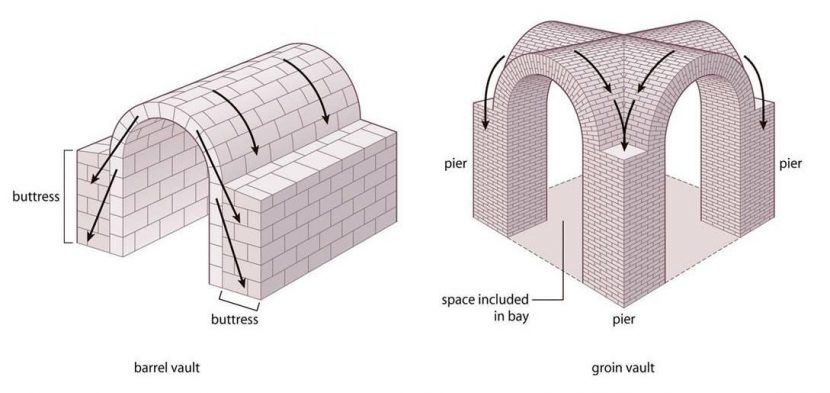
Ancient Roman Architecture Today
These were just some of the inventions that gave famous Roman architects a head start from the rest of the world, allowing their works of architectural art to be renowned worldwide, timelessly. Some of these ancient roman architecture are still admired and visited by tourists every year. Here are 12 ancient Roman architectural buildings you can visit!
1. The Roman Colosseum (Flavian Amphitheatre)
Rome’s great gladiatorial arena, the Roman Colosseum or Flavian Amphitheatre, is the most monumental of the city’s ancient sights and has name and fame across the globe. It symbolizes the raw, ancient Roman culture, with tiered 50,000 seats encircling the arena, built on top of an underground complex.
The Colosseum is the largest Roman amphitheatre, with an elliptical structure of 188 meters long, having 80 entrances and divided into 5 levels. The areas were allotted to the spectators by order of their ranks in the social class, i.e, the higher the rank, the closer to the arena. Today, it stands in ruins, but it is nonetheless impressive enough to make it into the list of the Seven Wonders of the modern world.
Additionally, scattered all over the Empire, more than 200 large and countless small more amphitheatres exist. Almost half of these are situated in Italy. These were used to hold gladiator contests, public spectacles such as re-enactments of famous battles, animal hunts, theatrical productions and executions.
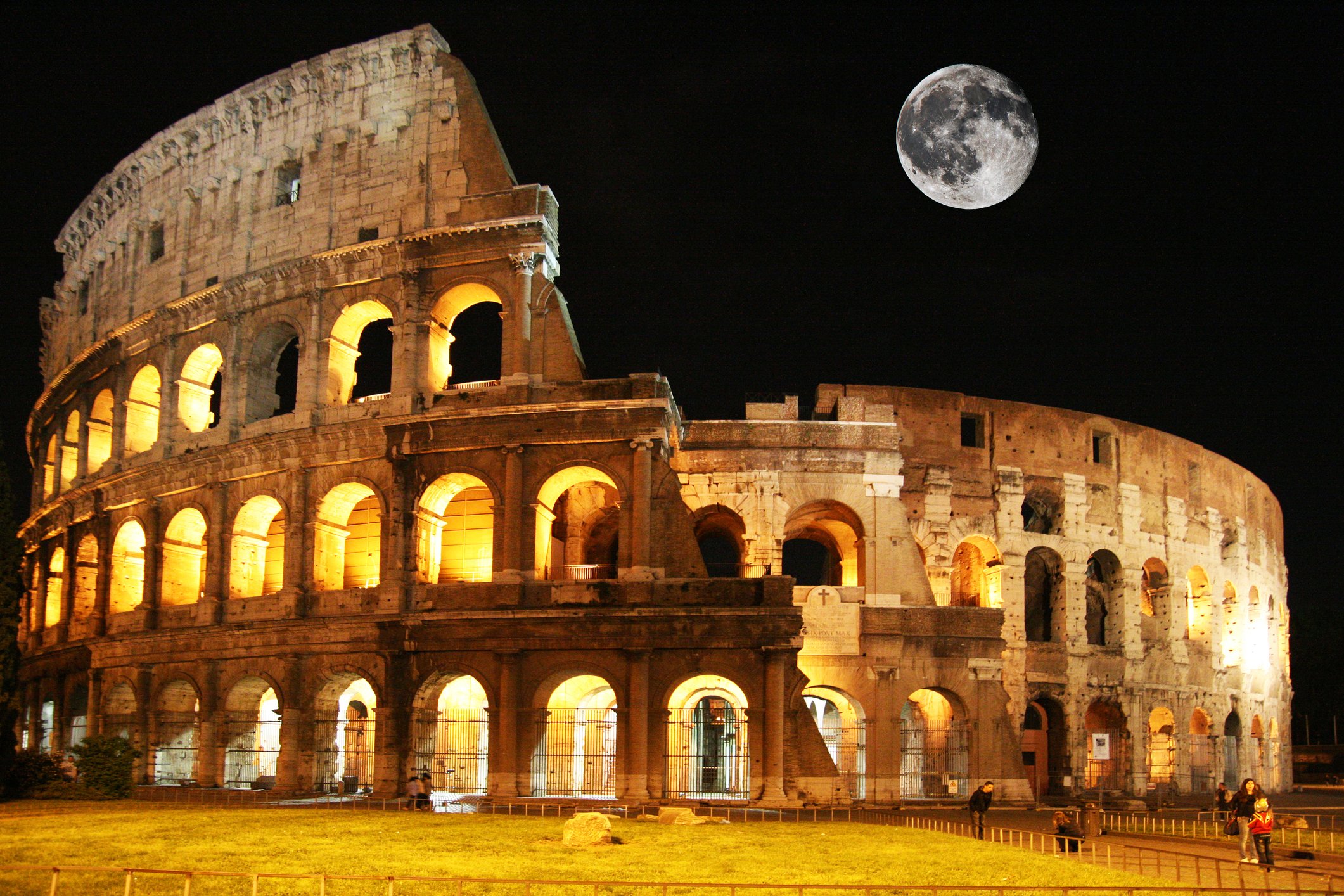
2. Teatro Marcello
The theatre of Marcellus, Teatro Marcello, is a seemingly smaller version of the Colosseum. Vespasian built the Colosseum in 72 AD, but Teatro Marcello was inaugurated even earlier in 12 BC by Augustus, who actually dedicated it to his designated successor and nephew, Marcellus.
At the time of its inauguration, Teatro Marcello was second to the Theatre of Pompey in terms of its size. It encompassed 41 arches for each of the three tiers: Doric for the first two and Ionic for the last. The theatre could house well up to 20,000 spectators and featured ramps and tunnels that allowed for quick exits.
The theatre has been repurposed several times in its lifetime. After falling out of use, it became buried halfway up the first tier, then it became a quarry for materials, then a fortified castle and finally by 1930, it was annexed. It was also, in fact, the Theatre of Marcellus that served as inspiration for the Colosseum. However, Teatro Marcello is a semi-circular theatre against the Colosseum which is a circular amphitheatre.
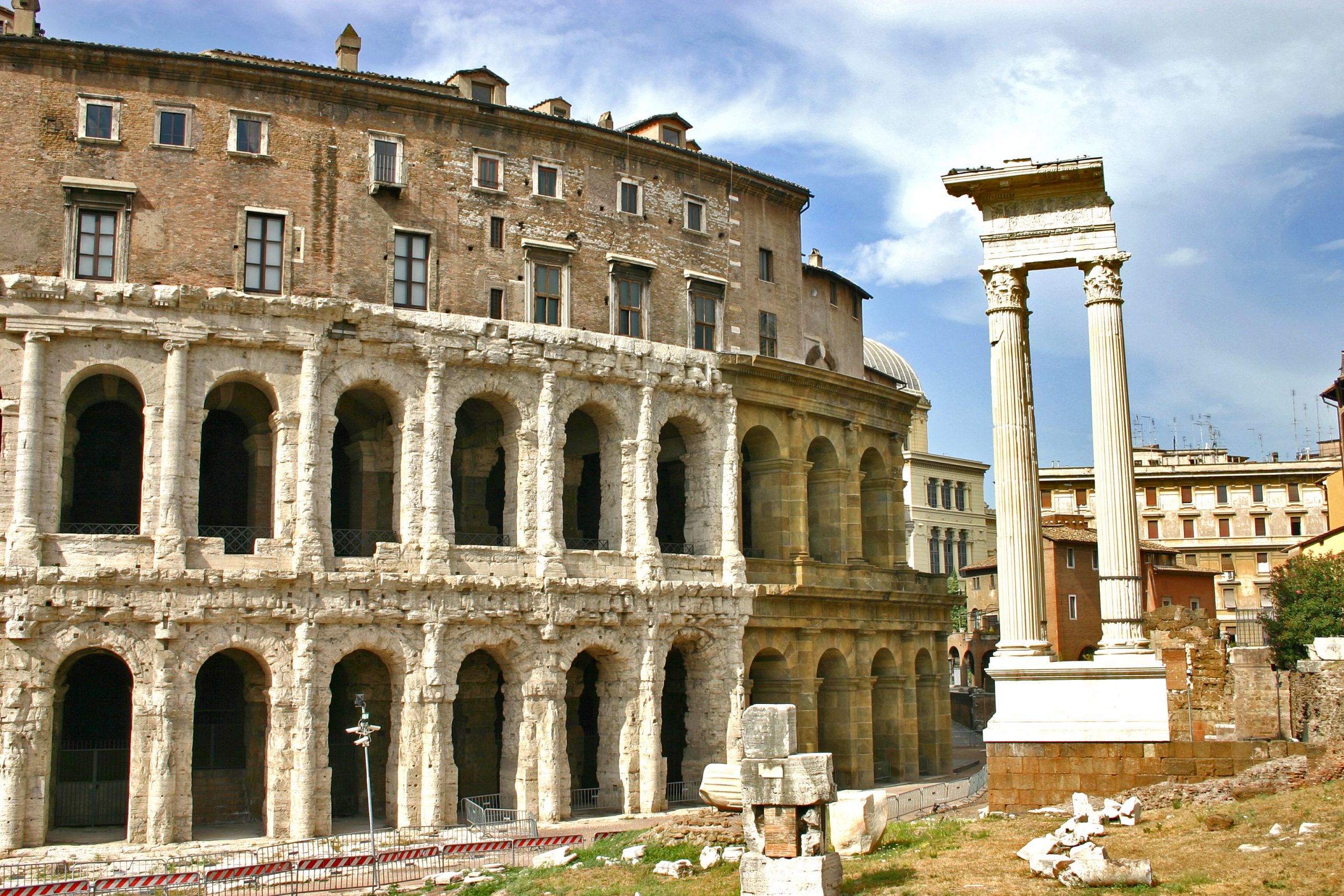
3. Saint Peter’s Basilica
St. Peter’s Basilica is one of the world’s holiest catholic shrines, located in Rome and visited by thousands of pilgrims and tourists every month. Built upon the tomb of St Peter, it dominates the skyline of Rome and covers 22,300 square meters, making it among the world’s largest churches. From the 1,400 minor basilicas scattered all over the globe, there are in total four major basilicas, one of which is St Peter’s Basilica. The three others are also situated in Rome: St John Lateran, St Paul’s and St Mary Major.
Initially, St Peter’s Basilica was completed in 349 AD and stood for around 1000 years until it began deteriorating. Fearing its collapse, Pope Julius II commanded it to be demolished and rebuilt. The new version was constructed in 120 years and flaunted the artistry of Roman Renaissance period.

4. The Pantheon
The Pantheon is considered the masterpiece of ancient Roman architecture, and rightfully so. It is the best-preserved building from ancient Rome, with a concrete structure veneered with bricks. The spectacular concrete dome rising from the walls and the front porch of Corinthian columns, which support a gabled roof with a triangular pediment, are iconic examples of ancient Roman architecture. The original purpose of the Pantheon’s construction is still debatable, but it is widely believed to have been a temple or a dynastic sanctuary..
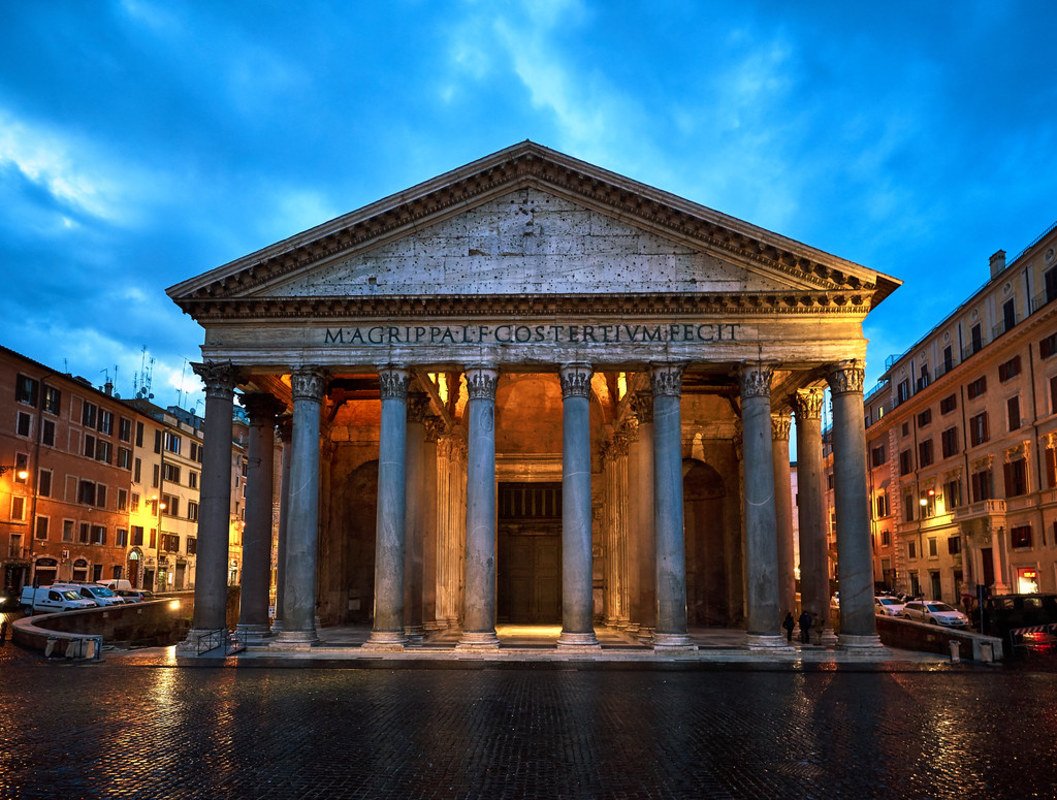
5. Ara Pacis
The Ara Pacis, or the Altar of Peace, is a prime example of ancient Roman architecture. It is located in the interior of a closed structure carved in Carrara marble which is in Campo Marzio, a large area outside the walls of the city that gave entrance to Rome from the north. The monument celebrates the peace in the Mediterranean area established by Emperor Augustus after his victorious campaigns in Hispania and Gaul, between the years 13 BC and 9 BC. It was dedicated to the Roman Goddess of peace, to whom a ram and two oxen were sacrificed each year at this altar.
Ara Pacis Museum is a fascinating sight because it appears to be a hybrid of the ancient roman architecture and modern architecture. This intricately decorated monument is covered in friezes depicting figures, battles and processions, while the altar is enclosed in the contemporary outer steel and glass structure. It served as a temple for the sacrifice of sacred animals where only priests and vestals participated, making it a very exclusive site. Even today, it is the only architectural masterpiece to be located on the inside of a museum.
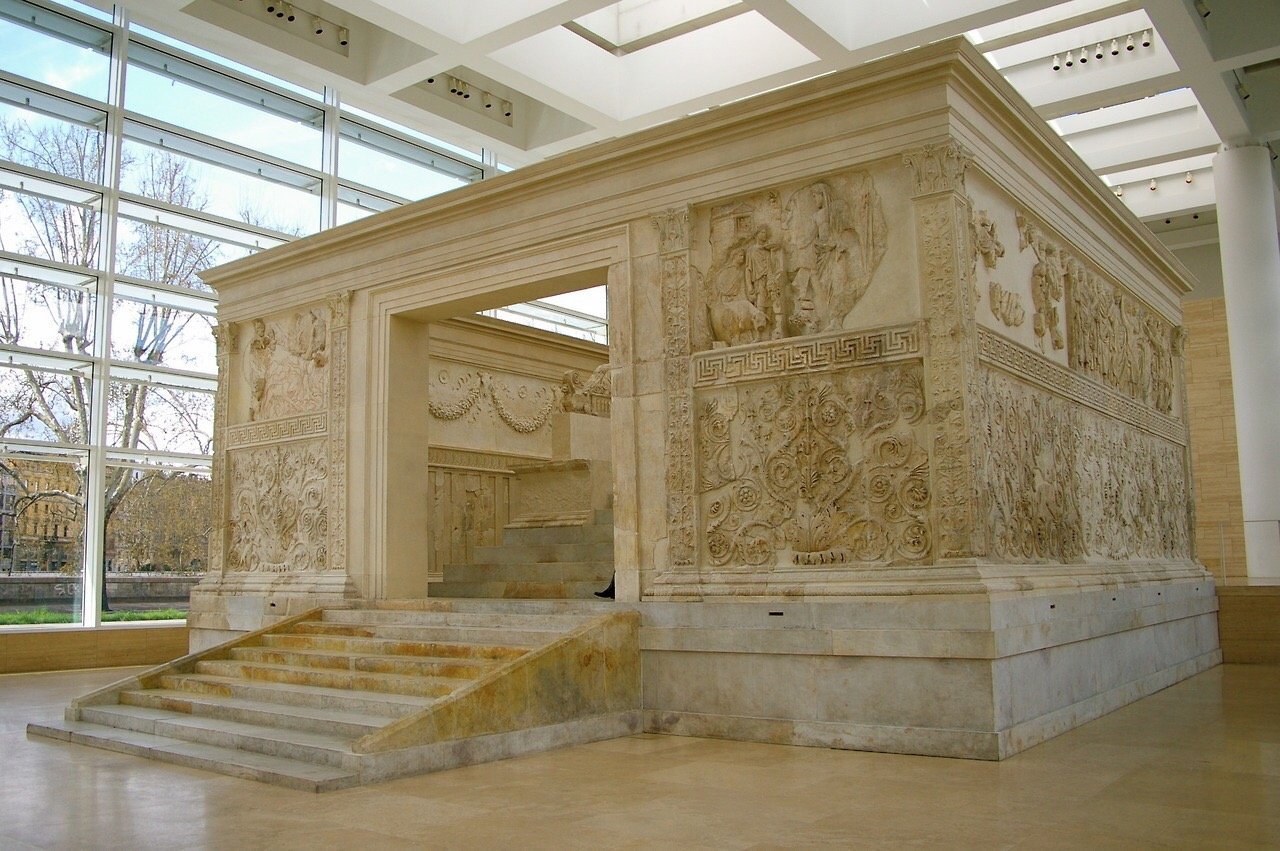
6. Circus Maximus
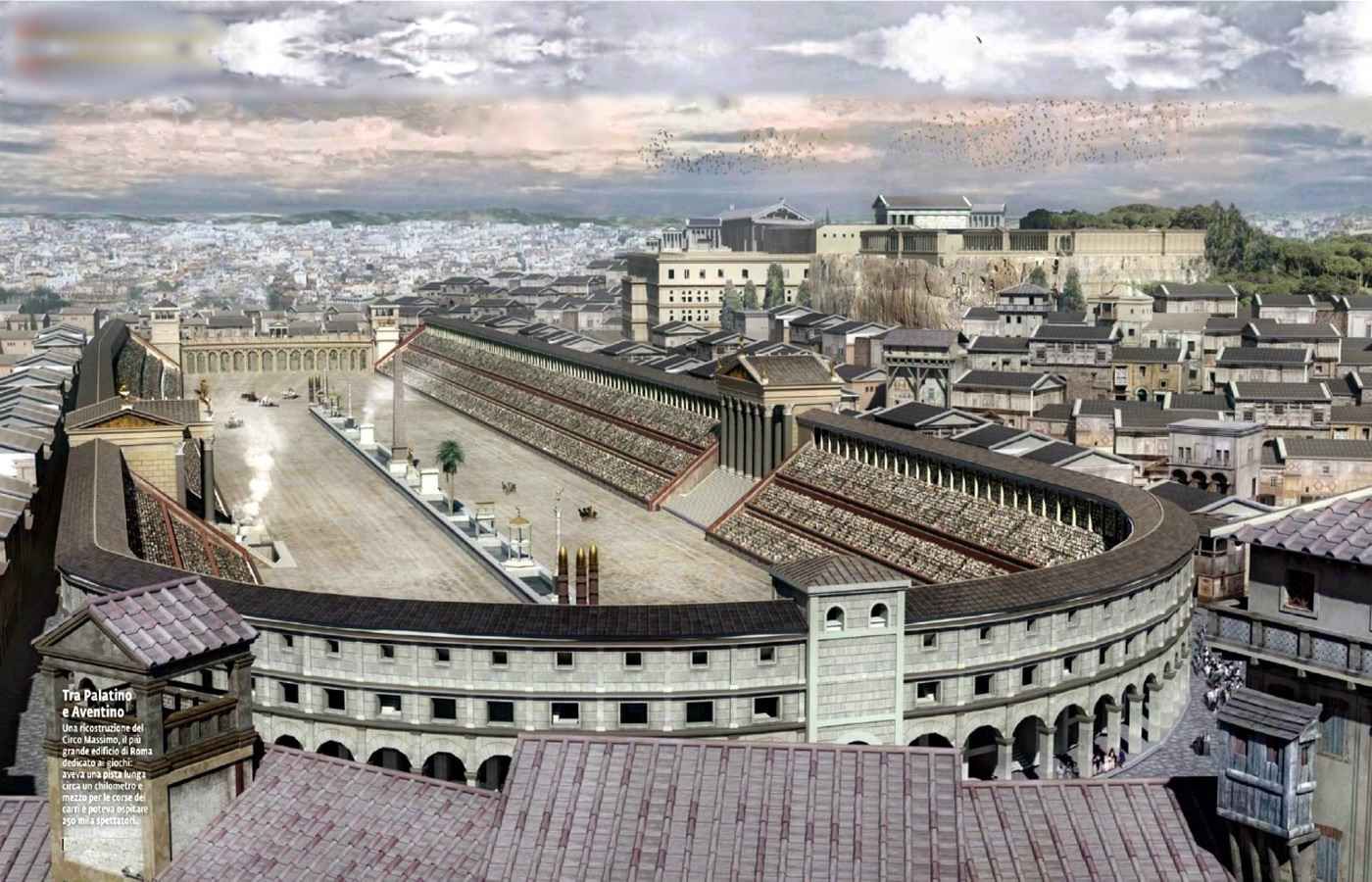
7. Triumphal Arches
The tradition of commemorating significant events with triumphal arches originated with the ancient roman architectures, and it soon became a trend around the world. The triumphal arches, which feature inscriptions and sculptures, were typically built with a single, double, or triple entrance to celebrate military victories. The most iconic example of this type of ancient Roman architecture is the Arc de Triomphe, commissioned by Napoleon in 1806 after his victory at Austerlitz. Today, several other triumphal arches of ancient Roman architecture still stand to tell the great stories of the ancient world.
8. Arc de Triomphe
The Arc de Triomphe is a monumental triumphal arch that draws inspiration from ancient Roman architecture, built during Napoléon’s era and commissioned by himself following his famous military victory at the Battle of Austerlitz in 1805. Today, it stands as one of the main symbols of Paris after the Eiffel Tower, showcasing the timeless appeal and enduring legacy of ancient Roman architectural style.
Rising to a height of 146 ft (50 metres) tall, with a width of 148 ft (45 metres) and depth of 72 ft (22 metres), the arch also serves as the location of the Tomb of the Unknown Soldier, dedicated in 1921 to honor French soldiers who died during World War I and remained unidentified.
The four pillars of the arc represent four important victories, including the French resistance during the War of the Sixth Coalition in 1814, the Treaty of Paris in 1815, La Marseillaise, and the Treaty of Schonbrunn in 1810, underscoring the importance and influence of ancient Roman architecture on modern architecture and design.
9. The Arch of Septimius Severus
The Arch of Septimius Severus is an impressive example of ancient Roman architecture, constructed in 203 CE to commemorate Roman victories over the Parthians in the final decade of the 2nd century CE.
This iconic monument features three arches that are typical of later Roman triumphal arches, with the larger central archway intended for traffic while the two outer arches were closed off by steps. The inscription with gilded bronze lettering is a dedication to Septimius Severus and his two sons Caracalla and Geta, who ‘restored the Republic and expanded the dominion of the Roman people,’ highlighting the historical significance and grandeur of ancient Roman architecture.
10. Roman Aqueducts
In a time when people were travelling certain distances to collect water, the Romans built conduit to supply water to their densely populated cities. The Aqueducts were costly structures and demanded quite a bit of engineering.
Featuring the best-preserved relics, the aboveground arches which were, in fact, only a small section of the entire system. Roman engineers created a gentle downward slope all the way from start to finish so that the only force needed to power the water’s progress was gravity.
11. Pont du Gard
The Pont du Gard, or the Gard Bridge an another example of ancient roman architecture, was constructed without the use of any mortar; Roman engineers built this three-story masterpiece by fitting together giant blocks of precisely cut stones. Each of these weighed up to six tonnes.
The Pont du Gard was a pivotal structure in an aqueduct that stretched over 31 miles (50 kilometres) in length. This engineering marvel supplied water to the city of Nimes and is one of the few surviving aqueducts constructed during the Roman Empire present.
12. Aqueduct of Segovia
The Aqueduct of Segovia is an impressive example of ancient Roman architecture, built during the second half of the 1st century A.D. It supplied water from the Frío River to the city for centuries, and even into the 20th century.
This monumental structure runs along 14 kilometers of rolling landscape, and the aqueduct’s design adjusts to the contours of the valley hills. The tall, two-story arcades are supported by pillars and arches made of solid blocks of stone fit closely together with little or no mortar, a testament to the incredible engineering skills of ancient Roman builders. The lower arches also alternate in height according to the structure’s adaptation to the contours of the land. Interestingly, locals refer to this aqueduct as “Puente de Diablo” or Devil’s Bridge, due to a local legend detailing Lucifer’s part in the construction of the bridge.
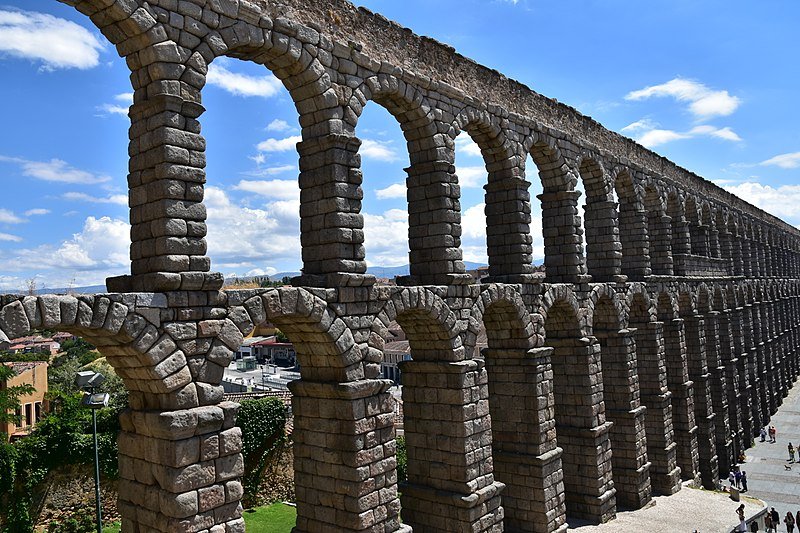
Ancient Roman Road Network
The famous quote that says “All roads lead to Rome” perfectly encompasses the fact that the Romans built an unparalleled network of roads, covering 50,000 miles and spanning the entire Empire.
These roads were mainly designed for military exploitation and primarily built by the legions themselves, as they stretched the frontiers. The road structure consisted of a metal surface on a solid foundation of earth or stone.
Ancient Roman Architects
In the world of ancient Roman architecture, credit for any architectural structure was not given to the architect who conceived and oversaw the ground realization of the project, but rather to the person who commissioned or paid for the project. Due to this practice, not many ancient Roman architects are well-known today. However, a few have made a name for themselves, such as Apollodorus of Damascus, who was favored by Roman emperor Trajan (Marcus Ulpius Traianus) during his reign from 98 to 117 CE. Another well-known ancient Roman architect is Vitruvius, thanks to his influential work ‘On Architecture,’ a 10-volume study of ancient Roman architecture which has survived in its complete form. This book is a valuable resource for anyone interested in the principles and techniques of ancient Roman architecture.
Ancient Roman Architecture Still Stands Strong
Ancient Roman architecture paved the way for modern architecture, pun intended, by pushing all boundaries of physics and art that were previously unexplored. As a result, architecture became an imperial tool to demonstrate to the ancient world that Rome was culturally superior. Finally, Roman Architecture has left a timeless influence on the modern world, with structures being built even today to emulate the grandeur and the artistic masterpieces that are fundamental to Roman heritage.
